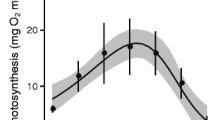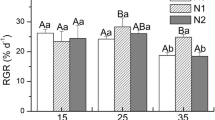Abstract
The aim of the study was to determine the influence of total dissolvedsolids/salinity (mg L-1 TDS) on photosynthetic activity of Nodularia spumigena strain 001E isolated from Lake Alexandrina, SouthAustralia, using photosynthesis-irradiance (PI) curves. N. spumigena001E cultures were grown in ASM medium at a range of TDSconcentrations (360, 6,600, 13,200, 19,800, 26,400 mg L-1)at an irradiance of 30 μmol m-2 s-1 (PAR, 400–700 nm) at 25 °C. The PI relationship was determined at 25 °Cfor irradiances between 0 and 500 μmol photon m-2s-1 (PAR). The initial slope of PI curve, α, a function of lightharvesting efficiency and photosynthetic energy conversion, decreasedproportionally with an increase in salinity from 360 to 26,400 mgL-1 TDS. The maximum rate of photosynthesis (Pmax),occurred at 6,600 mg L-1 TDS. No influence of salinity onIk, the irradiance at which Pmax was measured, or on Rd, the dark respiration rate, was identified.
Similar content being viewed by others
References
Baly ECC (1935) The kinetics of photosynthesis. Proc. R. Soc. Lond. B 117: 218-239.
Codd GA, Steffensen DA, Burch MD, Baker PD (1994) Toxic blooms of cyanobacteria in Lake Alexandrina, South Australia-Learning from history. Aust. J. mar. freshwat. Res. 45: 731-736.
Dubinsky Z, Falkowski PG, Post AF, Van Hes UM (1987) A system of measuring phytoplankton photosynthesis in a defined light field with oxygen electrode. J. Plankton Res. 9: 607-612.
Eriksson JE, Toivola D, Meriluoto JAO, Karaki H, Han Y, Hartshorne D (1990) Hepatocyte deformation induced by cyanobacterial toxins reflects inhibition of protein phosphatases. Biochem. biophys. Res. Comm. 173(3): 1347-1353.
Geider RJ, Osborne BA (1992) Algal Photosynthesis. Chapman & Hall, New York.
Gorham PR, McLachlan S, Hammer UT, Kim WK (1964) Isolation and culture of toxic strains of Anabaena flos-aquae (Lyngb.) de Breb. Mitt. int. Ver. Limnol. 15: 796-804.
Greenberg AE, Clesceri LS, Eaton AD (1985) Standard Methods for the Examination of Water and Wastewaters. American Public Health Association Washington DC, USA.
Hibino T, Lee BH, Rai AK, Ishikawa H, Kojima H, Tawada M, Shimoyama H, Takabe T (1996) Salt enhances photosystem I content and cyclic electron flow via NAD(P)H dehydrogenase in the halotolerant cyanobacterium Aphanothece halophytica. Aust. J. Plant Physiol. 23: 321-330.
Hobson P, Burch M, Fallowfield HJ (1999) Effect of total dissolved solids and irradiance on growth and toxin production by Nodularia spumigena. J. appl. Phycol. 11: 551-558.
Jasby AD, Platt T (1976) Mathematical formulation of the relationship between photosynthesis and light for phytoplankton. Limnol. Oceanogr. 21(4): 540-547.
MacKintosh C, Beattie KA, Klumpp S, Cohen P, Codd GA (1990) Cyanobacterial microcystin-LR is a potent and specific inhibitor of protein phosphatases 1 and 2A from both mammals and higher plants. FEBS Letters 264(2): 187-192.
Ohta T, Sueoka E, Iida N, Komori A, Suganuma M, Nishiwaki R, Tatematsu M, Kim S, Carmichael WW, Fujiki H (1994). Nodularin, a potent inhibitor of protein phosphatases 1 and 2A, is a new environmental carcinogen in male F344 rat liver. Cancer Research 54: 6402-6406.
Platt T, Gallegos CL, Harrison WG (1980) Photoinhibition of photosynthesis in natural assemblages of marine phytoplankton. J. mar. Research 38: 687-701.
Reed RH, Stewart WDP (1988) The response of cyanobacteria to salt stress. In Rogers LJ, Gallon JR (eds), Biochemistry of the Algae and Cyanobacteria. Oxford University Press, USA.
Runnegar MT, Kong S, Berndt N (1993) Protein phophatase inhibition and in vivo hepatotoxicity of microcystins. Am. J. Physiol. 28(6): 224-230.
Runnegar M, Berndt N, Kaplowitz N (1995) Microcystin uptake and inhibition of protein phosphotases: effects of chemoprotectants and self-inhibition in relation to known hepatic transporters. Toxicol. appl. Pharmacol. 134: 264-272.
Smith EL (1936) Photosynthesis in relation to light and carbon dioxide. Proc. natl Acad. Sci. 22: 504-511.
Steele JH (1962) Environmental control of photosynthesis in the sea. Limnol. Oceanogr. 7: 137-150.
Vonshak A, Kancharaksa N, Bunnag B, Tanticharoen M(1996) Role of light and photosynthesis on the acclimation of the cyanobacterium Spirulina platensis to salinity stress. J. appl. Phycol. 8: 119-124.
Webb WL, Newton M, Starr D (1974) Carbon dioxide exchange of Alnus rubra: a mathematical model. Oecologia 17: 281-291.
Author information
Authors and Affiliations
Rights and permissions
About this article
Cite this article
Hobson, P., Fallowfield, H. Effect of salinity on photosynthetic activity of Nodularia spumigena. Journal of Applied Phycology 13, 493–499 (2001). https://doi.org/10.1023/A:1012540928506
Issue Date:
DOI: https://doi.org/10.1023/A:1012540928506




